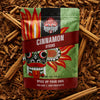
Sweet Temptations
Infuse warmth into baked goods, desserts, and comforting beverages.
Savory Sensations
Add a touch of exotic intrigue to curries, stews, and marinades.
Beyond the Kitchen
Explore the traditional uses of cinnamon in potpourri, herbal infusions, and natural remedies.
Magic of Sri Lanka: True Cinnamon
True Ceylon Cinnamon Vs Cassia Cinnamon
There are two types of cinnamon: Sri Lankan cinnamon (Cinnamomum Verum) aka "true Cinnamon", and Chinese cinnamon (Cinnamomum casssia) . Cassia is often mistaken for True Ceylon Cinnamon, especially if you're not familiar with the differences. While it’s a more affordable alternative, these two varieties come from distinct species and have noticeable differences in appearance, as well as physical and chemical properties.
What is Cassia Cinnamon?
Cassia Cinnamon, also known as Cinnamomum Cassia, is an aromatic bark similar to True Ceylon Cinnamon but differs in its Coumarin content, strength, and physical and chemical properties. Cassia bark is darker, thicker, and coarser, often retaining its rough. Mainly sourced from China, Indonesia, and Vietnam, Cassia Cinnamon is popular for its low cost. It is simply a thick single layer of bark that naturally curls into a stick, requiring less processing than Ceylon Cinnamon. With a strong, overpowering flavor and high Coumarin levels, Cassia Cinnamon is distinct and bold.
Did You Know ? Cassia Cinnamon Contains High Levels of Coumarin ?
Coumarin is a phytochemical with hepatotoxic and carcinogenic properties naturally existing in abundance in Cassia Cinnamon and is an anti-coagulant of the blood. Coumarin has also been shown to be toxic to the liver and kidneys, and it is also carcinogenic, which negates any health benefits of Cassia cinnamon.



